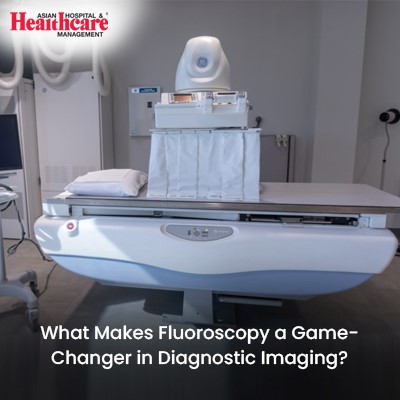This article explores how fluoroscopy, with its real-time imaging, precision in interventions, and diagnostic versatility, has revolutionized medical practice across specialties. It discusses benefits like minimally invasive procedures and challenges such as radiation exposure, while highlighting future innovations like AI integration and enhanced safety features, emphasizing fluoroscopy's pivotal role in modern healthcare.

Introduction:
In the domain of diagnostic imaging, fluoroscopy stands out as a pivotal technology that has revolutionized medical diagnosis and treatment. From its inception to modern advancements, fluoroscopy has evolved into a versatile tool with a wide range of applications across various medical specialties. This article delves into the essence of fluoroscopy, its technological principles, applications in healthcare, benefits, challenges, and future prospects, highlighting why it is considered a game-changer in diagnostic imaging.
I. Understanding Fluoroscopy: Technological Principles
Fluoroscopy is a real-time imaging technique that utilizes continuous X-ray beams to create dynamic images of internal structures within the body. Unlike static X-ray imaging, fluoroscopy provides live, moving images that enable healthcare professionals to visualize organ function, monitor procedures, and guide interventions in real time. The key components of fluoroscopy include an X-ray source, an image intensifier or digital detector, a fluoroscope, and a display monitor.
The process begins with the generation of X-rays from the source, which pass through the patient's body and interact differently with various tissues based on their density. The attenuated X-rays then strike the image intensifier or digital detector, where they are converted into visible images. These images are then displayed on a monitor, allowing physicians to observe the internal structures and dynamics of organs, blood vessels, gastrointestinal tract, and other systems.
II. Applications of Fluoroscopy in Healthcare
Interventional Procedures: Fluoroscopy plays a crucial role in guiding minimally invasive procedures such as angiography, cardiac catheterization, orthopedic surgeries, and gastrointestinal interventions. By providing real-time imaging, it enhances precision, reduces procedural risks, and improves patient outcomes.
Orthopedics: In orthopedic surgeries, fluoroscopy aids in visualizing bone fractures, joint movements, implant placements, and spinal procedures. It enables surgeons to navigate complex anatomical structures accurately and perform interventions with minimal invasiveness.
Gastrointestinal Imaging: Fluoroscopy is extensively used in gastrointestinal studies, including barium swallow tests, barium enemas, and esophagogastroduodenoscopy (EGD). It allows for the evaluation of swallowing disorders, digestive tract abnormalities, and the detection of gastrointestinal diseases.
Cardiology: In cardiology, fluoroscopy assists in cardiac catheterization procedures, electrophysiology studies, and coronary angiography. It provides real-time visualization of the heart's chambers, valves, blood flow, and coronary arteries, aiding in the diagnosis and treatment of cardiovascular conditions.
Pain Management: Fluoroscopy-guided interventions are vital in pain management, such as epidural steroid injections, nerve blocks, and spinal cord stimulator placements. Precise needle placement under fluoroscopic guidance ensures targeted delivery of medications and therapeutic agents.
Pulmonology: Fluoroscopy is utilized in bronchoscopy procedures to examine the airways, diagnose lung disorders, and guide bronchoscopic interventions. It enables pulmonologists to visualize lung function, detect abnormalities, and perform biopsies or therapeutic procedures.
III. Benefits of Fluoroscopy
Real-time Visualization: One of the primary advantages of fluoroscopy is its ability to provide dynamic, real-time images during procedures, allowing healthcare providers to monitor progress and make immediate adjustments.
Minimally Invasive Procedures: Fluoroscopy facilitates minimally invasive interventions, reducing the need for traditional open surgeries, lowering risks, shortening recovery times, and improving patient comfort.
Precision and Accuracy: The high-resolution images produced by fluoroscopy enhance precision in medical interventions, enabling physicians to target specific areas, deliver treatments accurately, and minimize damage to surrounding tissues.
Diagnostic Versatility: Fluoroscopy is versatile, capable of imaging various anatomical regions and systems, making it indispensable in multiple medical specialties such as radiology, cardiology, orthopedics, gastroenterology, and pulmonology.
Patient Safety: Despite its use of ionizing radiation, modern fluoroscopy systems incorporate dose-reduction techniques, real-time dose monitoring, and safety protocols to minimize radiation exposure and ensure patient safety.
IV. Challenges and Limitations
While fluoroscopy offers significant benefits, it also poses challenges and limitations that require attention:
Radiation Exposure: Prolonged or excessive use of fluoroscopy can lead to cumulative radiation exposure for healthcare professionals and patients. Proper training, adherence to safety protocols, and dose optimization strategies are essential to mitigate this risk.
Image Quality: Although fluoroscopy provides real-time imaging, the quality of images may vary based on factors such as patient anatomy, motion artifacts, equipment settings, and operator skills. Continuous advancements in imaging technology aim to improve image clarity and resolution.
Cost and Accessibility: Acquiring and maintaining fluoroscopy equipment can be costly, limiting its availability in some healthcare settings. Efforts to enhance affordability, expand access, and promote appropriate utilization are ongoing in the medical community.
Regulatory Compliance: Compliance with regulatory guidelines, quality assurance standards, and radiation safety protocols is crucial in fluoroscopy practice to ensure optimal patient care and safety.
V. Future Directions and Innovations
The future of fluoroscopy in diagnostic imaging holds promising developments and innovations:
Advanced Imaging Techniques: Continued advancements in imaging technology, such as digital fluoroscopy, 3D reconstruction, and spectral imaging, will enhance image quality, diagnostic capabilities, and procedural guidance.
Artificial Intelligence (AI) Integration: AI-driven algorithms and machine learning applications are poised to augment fluoroscopy by automating image analysis, optimizing radiation doses, and assisting in real-time decision-making during procedures.
Enhanced Safety Features: Ongoing research focuses on developing radiation dose monitoring systems, dose reduction algorithms, and radiation shielding technologies to further enhance safety for both patients and healthcare professionals.
Telefluoroscopy and Remote Guidance: Telemedicine integration with fluoroscopy enables remote consultations, virtual guidance for procedures, and collaborative healthcare delivery, expanding access to specialized care.
Conclusion:
Fluoroscopy has emerged as a game-changer in diagnostic imaging, revolutionizing medical practice across diverse specialties. Its real-time imaging capabilities, precision-guided interventions, and diagnostic versatility have significantly impacted patient care, treatment outcomes, and procedural safety. Despite challenges, ongoing advancements and future innovations promise to further elevate fluoroscopy's role in modern healthcare, reinforcing its status as an indispensable tool for medical professionals striving for excellence in diagnosis and treatment.